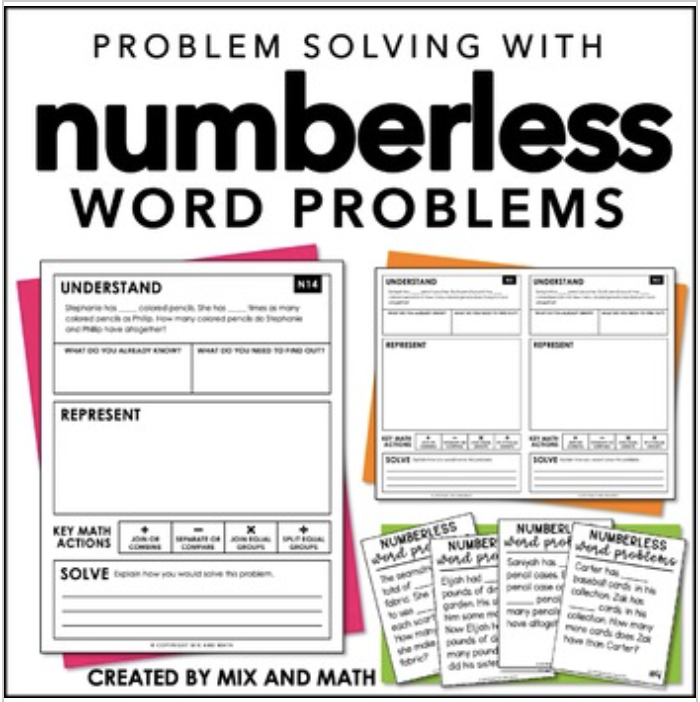The Power of Numberless Word Problems
How many times have you watched a student read (…skim) a word problem and then immediately start computing the answer before you have even had a chance to give directions? No matter how much we talked about the importance of slowing down, actually THINKING about what the problem was saying and taking time to understand, I always have those students who just pull out the numbers, choose a random operation, and solve.
And let me tell you… it. drives. me. crazy.
This is about the time that I throw a new word problem on the board, take my favorite black sharpie and color over the numbers because I know numberless word problems are exactly what they need. So why does a word problem without numbers fix all my problems? Here’s why.
Numberless word problems shift the focus from solving to understanding.
When students see numbers in a word problem, they know that the expectation is to solve. They are “done” when they’ve added, subtracted, multiplied, or divided and they’re left with an answer. When the numbers are removed from the problem and replaced with blanks, the focus immediately shifts away from solving, because there’s nothing to solve! There is no operation to do because there are no numbers!
When students aren’t being distracted by numbers and the pressure to solve, they have the opportunity to focus on the context. Numberless word problems force students to take time to truly make sense of the problem and determine what actions are being done in the problem. When they understand the actions in the problem, they can then translate that to an operation, or a math action.
All four operations are mathematical representations of a real life action (joining, separating, sharing, scaling, etc.). Unfortunately, students often miss this because they are so quick to just pull out the numbers and solve (or they have been taught to diminish word problems to a set of key words… but that is a whole new discussion for whole other day). When students work with numberless word problems frequently, they begin to see similarities in certain problems. They may notice that addition problems seem to be combining or joining two amounts while subtraction problems seem to be separating amounts or identifying the difference. These are the actions students need to understand in order to find success representing real life mathematically.
watch the video...
Numberless word problems allow for easy differentiation.
Many students struggle with word problems because of the numbers themselves. Some students are so defeated by seeing number like 1,236 or 0.05 or 7/12 in a word problem, that they don’t have the motivation to even attempt the problem. Why would they? If they know they will struggle with the computation and the goal of the problem is to solve, then no matter how hard they work to understand the problem, they still have no chance to be successful.
When the numbers are removed, all students have the ability to work towards understanding of the problem because the numbers are not a limitation. They can think about the problem in terms of whatever numbers are comfortable to them. They can use problem-solving strategies to make sense of the problem without the pressure of computing “really hard numbers” in the end.
Students do need to know how to compute numbers, so after students have taken the time to understand the problem, you as the teacher can provide numbers that are appropriate for them to insert into the blanks and begin solving. I typically provide 3-5 sets of numbers for students to choose from to insert into the problem and solve.
Try a numberless word problem sort!
One of my favorite problem solving activities is a numberless word problem sort. It’s not anything revolutionary. It is exactly what it sounds like… students sort a set of numberless word problems by the math action (operation) that they would use to solve the problem. It is such an easy activity but it is SO POWERFUL.
If you want students to practice computation, roll a dice or draw a number card and insert the numbers into the problem. Now students have taken time to understand the problem and they get computation practice. It’s a win-win scenario! I highly recommend that every math teacher try this out with their students. It will likely reveal some misconceptions students might have!
Want to try numberless word problems in your classroom?
If you are an upper elementary teacher, check out this numberless word problem sort for FREE! This activity is powerful in helping students focus on the meaning of each operation.
If you are a 5th or 6th grade teacher, here is the set of numberless word problems I made for my students. For some reason, fractions tend to totally throw students off in word problems! It was encouraging for my students to see that they can understand these problems with or without fractions.
It also was really good practice for multiplying and dividing fractions because these operations tend to be a bit tougher to identify when you are working with fractions. Without the numbers, students were able to identify similarities and differences in the problems themselves instead of focusing only on the numbers.
So, what do you think? Have you given your students word problems without numbers?




If you’re frustrated because your students just aren’t engaged in your math lessons, you’re not alone. I’ve been there too, and the good news is that it’s easy to fix! In this post, I share four free, easy-to-implement strategies that help you quickly boost engagement in your math classroom.